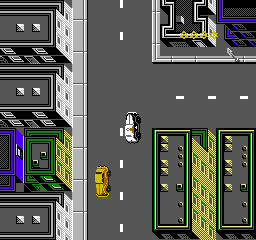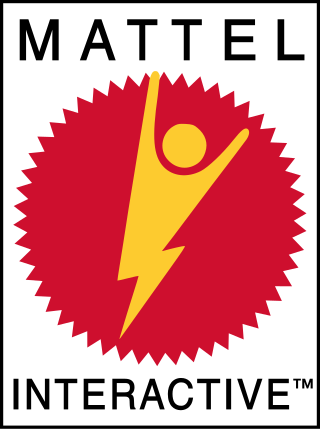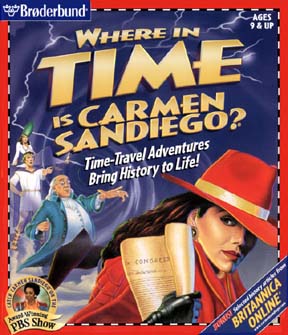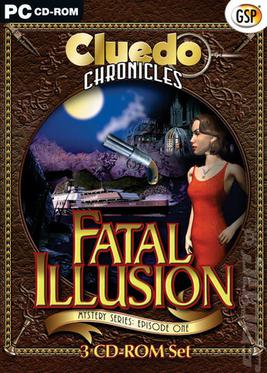Related Research Articles
JumpStart was an educational media franchise created for children, primarily consisting of educational games. The franchise was developed by JumpStart Games and expanded beyond games to include workbooks, direct-to-video films, mobile apps, and other media. It was officially launched on March 10, 2009, offering a blend of educational content and entertainment experiences.
The Learning Company (TLC) was an educational software company founded in 1980 in Palo Alto, California and headquartered in Fremont, California. The company produced a grade-based line of learning software, edutainment games, and productivity tools. Its titles included the flagship series Reader Rabbit, for preschoolers through second graders, and The ClueFinders, for more advanced students. The company was also known for publishing licensed educational titles featuring characters such as Arthur, Scooby-Doo, Zoboomafoo, and Caillou.

The ClueFinders is an educational software series aimed at children aged 8–12 that features a group of mystery-solving teenagers. The series was created by The Learning Company as a counterpart to their Reader Rabbit series for older, elementary-aged students. The series has received praise for its balance of education and entertainment, resulting in numerous awards.

Dick Tracy appeared in the following video game tie-ins for the motion picture:

Reader Rabbit is an educational game franchise created in 1984 by The Learning Company. The series is aimed at children from infancy to the age of nine. In 1998, a spiritual successor series called The ClueFinders was released for older students aged seven to twelve.

Nancy Drew: Legend of the Crystal Skull is the 17th installment in the Nancy Drew point-and-click adventure game series by Her Interactive. It is available for play on Microsoft Windows platforms. It has an ESRB rating of E for moments of mild violence and peril. Players take on the first-person view of fictional amateur sleuth Nancy Drew and must solve the mystery through interrogation of suspects, solving puzzles, and discovering clues. There are two levels of gameplay, Junior and Senior detective modes, each offering a different difficulty level of puzzles and hints, however neither of these changes affect the actual plot of the game. The game is loosely based on a book entitled The Mardi Gras Mystery (1988).

Carmen Sandiego is a media franchise based on a series of computer video games created by the American software company Broderbund. While the original 1985 Where in the World Is Carmen Sandiego? video game was classified as a "mystery exploration" series by creators and the media, the series would later be deemed edutainment when the games became unexpectedly popular in classrooms. The franchise centers around the fictional thieving villain of the same name, who is the ringleader of the criminal organization V.I.L.E.; the protagonists are agents of the ACME Detective Agency who try to thwart the crooks' plans to steal treasures from around the world, while the later ultimate goal is to capture Carmen Sandiego herself.
Barbie Horse Adventures is a series of video games based on Mattel's Barbie line of dolls. The series is aimed at children and involves various aspects of equestrianism.
Mystery Case Files is a video game series originally developed by the internal studios of Big Fish Games. Some installments were developed by Eipix Entertainment between 2015 and 2019 and Elephant Games who developed sequels from 2013 to 2014. The newest installments were developed by GrandMA Studios. The Mystery Case Files series is known for its hidden object puzzles where, in order to progress through a game, the player plays the role of a Master Detective and must find a certain number of items hidden somewhere on a painted scene.

Scooby-Doo Mystery is the name of two video games released by Acclaim Entertainment and Sunsoft in 1995 based on the Scooby-Doo animated series. One of the games was released for the Sega Genesis and features a more traditional adventure game-style interface. The other title, released for the Super Nintendo Entertainment System, is an adventure game with platforming elements. Both were released only in North America. In both games, players take control of Shaggy Rogers and Scooby-Doo, who help solve various mysteries with other members of Mystery Incorporated who serve minor roles during gameplay.
There have been a variety of Sesame Street video games released for video game platforms. Most of the Sesame Street video games were published and developed by NewKidCo.

Mattel Interactive was a video game publisher and software distributor.
The Magic School Bus is a series of educational software video games developed by Music Pen and published by Microsoft via their Microsoft Home brand. The interactive adventures are part of the larger franchise and based with The Magic School Bus original series books and public television series.

Carmen Sandiego's Great Chase Through Time is a 1997 edutainment point-and-click adventure game developed by Broderbund for Microsoft Windows and Macintosh devices. The game is a remake of the 1989 time-travel title Where in Time Is Carmen Sandiego?, making it the second Time video game in the Carmen Sandiego franchise. The game was strongly influenced by the short-lived PBS game show, Where in Time Is Carmen Sandiego?. The game was previewed at the 1997 Toy Fair in New York City. A demo version was included on the CD for Carmen Sandiego Word Detective and was available on the Carmen Sandiego website. After Broderbund was sold to The Learning Company, the game was re-released with the new title - Carmen Sandiego's Great Chase Through Time - but with minimal redesign.

Clue Chronicles: Fatal Illusion is a Windows point-and-click adventure game based on the Cluedo franchise, known as Clue in North America. It is a reinterpretation and adaption of the Clue board game as an adventure game including many of the original characters. The game was distributed with a variety of covers, each featuring a different murder weapon.
Madeline is a series of educational point-and-click adventure video games which were developed during the mid-1990s for Windows and Mac systems. The games are an extension of the Madeline series of children's books by Ludwig Bemelmans, which describe the adventures of a young French girl. The video-game series was produced concurrently with a TV series of the same name, with characters and voice actors from the show.
Several video games based upon Blue's Clues, a children's educational television series by Nickelodeon, have been released, educational video games and web browser games based on the show. Most of the PC CD ROM-format titles were developed and published by Humongous Entertainment.

Writer Rabbit is a 1986 video game in the educational video game, part of the Reader Rabbit franchise. It was remade as Reader Rabbit 3 for DOS in 1993, which was then re-released for Windows and Macintosh in 1994 under the title "Reader Rabbit 3 Deluxe!".

Magic Fairy Tales: Barbie as Rapunzel is a 1997 educational adventure game developed by Media Station and published by Mattel Media.
Cluedo, known as Clue in North America, is a murder mystery-themed multimedia franchise started in 1949 with the manufacture of the Cluedo board game. The franchise has since expanded to film, television game shows, book series, computer games, board game spinoffs, a comic, a play, a musical, jigsaws, card games, and other media.
References
- ↑ Michael White Associated Press (December 18, 1999). "KIDS' PCS SHIP LATE; POST-HOLIDAY DELIVERY LIKELY". Daily News. Archived from the original on 2017-03-15.
- ↑ "Bestsellers". The Washington Post. December 21, 1998. Archived from the original on March 15, 2017.
- ↑ English, Susan (November 1, 1998). "NEW COVERAGE WOULD BENEFIT MANY PARTNERS". The Spokesman-Review. Archived from the original on 2017-03-15.
- ↑ "PLAYERS CONQUER ISLANDS". The Cincinnati Post. February 29, 2000. Archived from the original on 2017-03-15.
- ↑ "Girls Just Want to Have Fun This Holiday Season And You Can Help With Barbie Electronic Gaming Accessories". PR Newswire (press release). November 23, 1999.
- ↑ "YouTube gameplay video showing the puzzle pieces". YouTube . Archived from the original on 2021-11-04.
- ↑ "Mattel Media Reveals Detective BARBIE: The Mystery Cruise for PlayStation At Retail Stores Nationwide". Business Wire (press release). November 20, 2000.
- ↑ "Mattel Media Stuffs Stockings With Name Brand Hybrid Toys and Electronic Entertainment Products". PR Newswire (press release). November 14, 2000.
- ↑ Henning, Alex (September 21, 2020). "The Horrifying World of Doll-Based Video Games". Comic Book Resources . Retrieved November 4, 2021.
- ↑ "MEGA MIRROR: BARBIE POSER.(Features)". 1999-04-24. Archived from the original on 2017-03-15.
{{cite journal}}: Cite journal requires|journal=(help) - ↑ Cobbett, Richard (March 22, 2014). "Saturday Crapshoot: Detective Barbie". PC Gamer . Retrieved 2017-03-14.
- ↑ "SuperKids Software Review of Detective Barbie". SuperKids. Archived from the original on 2021-11-04. Retrieved 2017-03-14.
- ↑ "Обзор "Detective Barbie Platinum ( Kravchuk )"". 7Wolf (in Russian). January 9, 2002. Archived from the original on 2007-03-09. Retrieved 2017-03-14.
- ↑ Regna, Michelle (Dec 9, 2015). "21 Barbie Computer Games You Totally Forgot Existed". BuzzFeed . Retrieved 2017-03-14.
- ↑ Dakessian, Drew (March 2, 2021). "The 'Girl Games' of the '90s Were Fun and Feminist". Wired . Retrieved November 4, 2021.
- ↑ "SuperKids Software Review of Detective Barbie 2: The Vacation Mystery". SuperKids. Archived from the original on 2000-05-24. Retrieved 2017-03-14.
- ↑ "Games hold clue to Barbie's appeal; Barbie Detective 2: The Vacation Mystery. Mattel Media, $30. Windows 95/98. For age 5 and up. 2 1/2 stars.(Arts and Lifestyle)". 2000-02-20. Archived from the original on 2017-03-15.
{{cite journal}}: Cite journal requires|journal=(help) - ↑ "Electric ideas". 1998-12-08. Archived from the original on 2017-03-15.
{{cite journal}}: Cite journal requires|journal=(help)